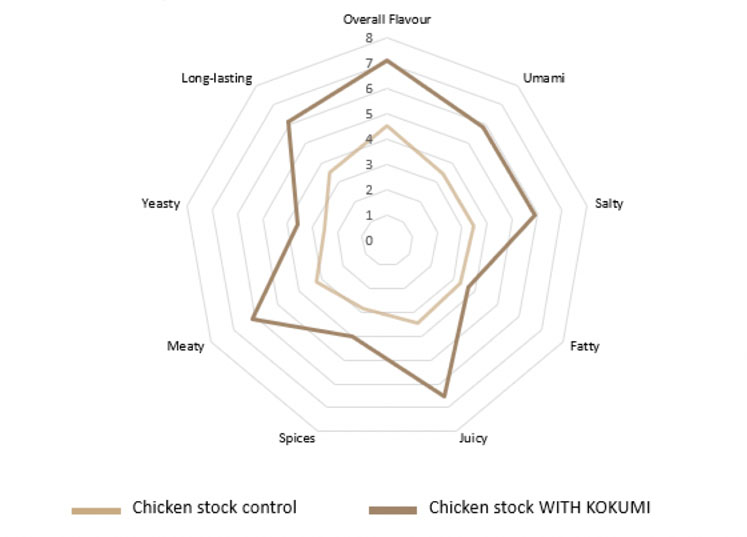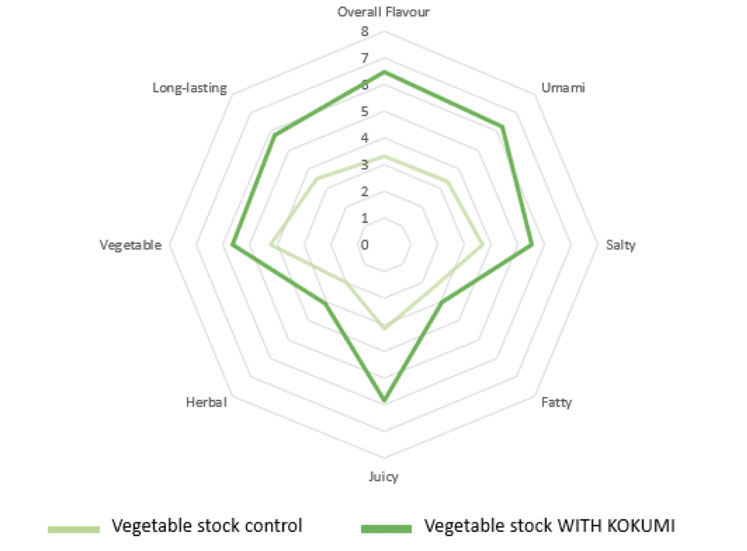Food manufacturers look to appeal to one or more of these tastes with their products, but it can be a challenge to create food that delivers real flavour while also being low on salt and sugar and complying with health guidelines. Here, we explore how kokumi might be the not-so-secret ingredient that many are looking for. Chris Whiting, Category Manager at Synergy Flavours, reports.
Enhancing flavour when removing salt
vAn emerging flavour concept, especially for Western audiences, kokumi is a Japanese word used to describe the rich, strong complexity of flavour in food. Kokumi is sometimes translated as “heartiness” or “mouthfulness,” but literally translates as “rich” (koku) “taste” (mi).
Figure 1: Sensory map showing profiling of the change in flavour caused by using the savoury kokumi taste enhancer with a low salt chicken stock cube; profiling was performed by trained panellists in a group discussion, giving an intensity score for the attributes shown
Rather than being a taste itself, kokumi functions more as a taste enhancer — lifting the perception of the other basic tastes — particularly sweet, umami and salt. The kokumi flavour is activated by amino acids or small peptides.
The tripeptide gamma-glutamyl-valyl-glycine is one of the strongest kokumi compounds known and is found in fish sauce, yeast, soya sauce, shrimp paste, cheese and beer. Kokumi works by enhancing the calcium receptors on the tongue to create a more intense, balanced and mouth-coating sensation.
A central ingredient in many savoury foods is, of course, salt. Salt’s role in enhancing flavour is clear, but it can also impact product stability, shelf-life and even texture in, for example, processed meats.
In a 2003 report on salt and health, The Scientific Advisory Committee on Nutrition (SACN) advised that “a reduction in average adult salt intakes to 6 g per day, with lower levels set for children, would lower population blood pressure levels and reduce the risk of cardiovascular disease.”1

Figure 2: Sensory map showing profiling of the change in flavour caused by using the vegetable kokumi taste enhancer with a low salt vegetable stock cube; profiling was performed by trained panellists in a group discussion, giving an intensity score for the attributes shown
Since then, five sets of targets have been published (2006, 2009, 2011, 2014 and 2017) covering around 80 individual product categories. The WHO suggests that a salt intake of less than 5 g per day for adults helps to reduce blood pressure and risk of cardiovascular disease, stroke and coronary heart attack.
With salt reduction high on many food developers’ agendas, many reformulation efforts are focused on accentuating flavour impact through other means. Kokumi heightens the perception of other flavours in a variety of applications and is thus increasingly being used to enhance the flavour of salt- and fat-reduced foods.
Synergy’s flavour scientists have developed a natural flavour with kokumi enhancing notes, which can be used in soups, stocks, ready meals and sauces (Figures 1 and 2).
The sensory profiling data shows that, in both instances, the kokumi flavour has improved the perception of the basic tastes (umami, salty), specific flavours and overall flavour delivery. In addition, it has also extended the length of time the panel perceived the flavour for.
However, because of the way the kokumi flavouring interacts with the base product matrix, different products can often require different solutions. As such, Synergy has developed a range of different kokumi taste enhancement profiles: savoury, vegetable, dairy and cheese.
The future of taste
With growing interest in Japanese food and culture thanks to the upcoming Olympics, kokumi is set to become better known in the West in the coming months and years. In its 2019 global food and beverage trend report, Edelman noted that kokumi “could enable food product developers to make great-tasting, healthy food options that consumers will actually enjoy.”
Reference
1. www.gov.uk/government/publications/sacn-salt-and-health-report.
